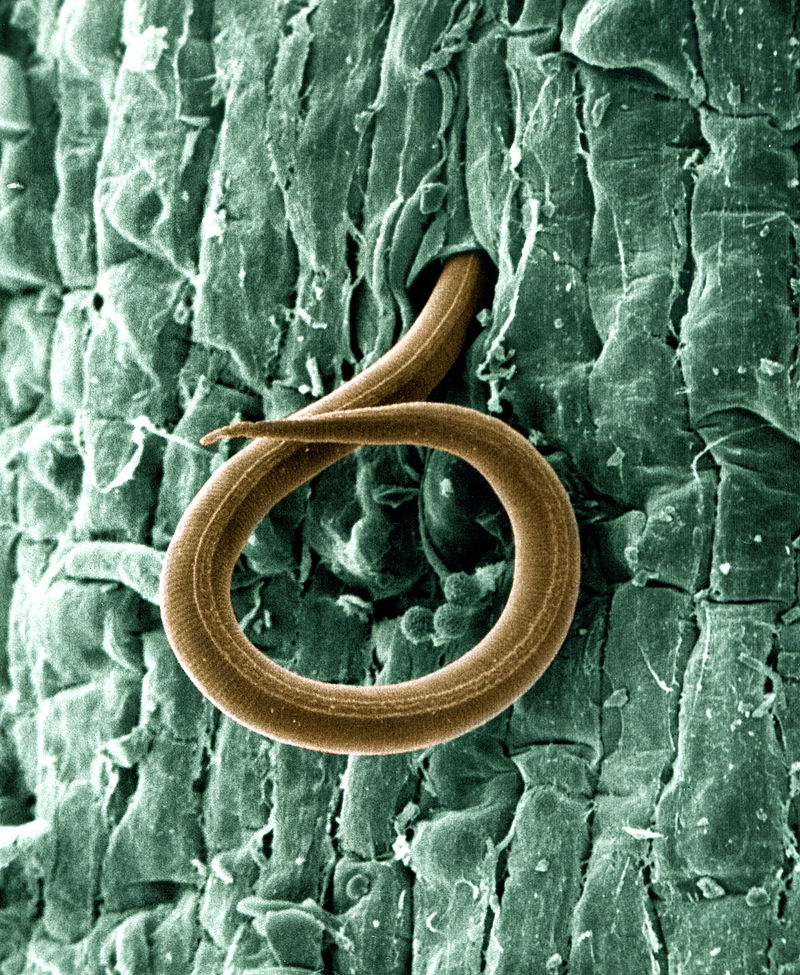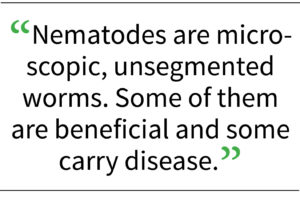Nematodes are microscopic, unsegmented worms. Some of them are beneficial and some carry disease.
![]()

Photo courtesy William Wergin and Richard Sayre. Colorized by Stephen Ausmus
A juvenile root-knot nematode (Meloidogyne incognita) penetrates a tomato root. Once inside, the juvenile, which also attacks cotton roots, robs the plant of nutrients.
By Kate Russell

Kate Russell
A perfectly healthy plant takes a sudden turn for the worse. It wilts. It shrinks. It changes color. It looks starved. It might be infected with root-knot nematodes.
Root-knot nematodes (Meloidogyne spp.) are plant parasites that thrive in regions with hot summers and short winters, causing problems in more than 2,000 different plants. They will infect pretty much everything in your Morgan Hill garden except onions and corn. And the only way to tell if a plant is infected with root-knot nematodes is to dig it up.
Nematodes are microscopic, unsegmented worms. Some of them are beneficial and some carry disease. Beneficial nematodes kill cutworms and corn ear-worm moths.
Disease-carrying nematodes include needle nematodes, stubby root nematodes, and root-knot nematodes. The problem with nematodes is that there are so many of them. It is estimated that, for every person on earth, there are 60 billion nematodes. (Thank goodness they aren’t all bad.)
There are more than 90 different types of root-knot nematodes and they occur worldwide. Females lay eggs in roots. Those eggs hatch into juveniles that go through several molts. During that time, they may stay in their mother’s plant or go find their own.
 Root-knot nematode larvae infect plant roots, causing galls to form. Galls are swellings that occur in response to invasion. Galls caused by bacterial or fungal infection contain bacteria or fungi, respectively. Galls caused by root-knot nematode larvae contain only plant tissue. These interfere with the uptake of water and nutrients, so young plants starve to death, and older plants struggle. Those struggling plants are more susceptible to other pests and diseases, as well as environmental stresses, such as drought or unhealthy soil.
Root-knot nematode larvae infect plant roots, causing galls to form. Galls are swellings that occur in response to invasion. Galls caused by bacterial or fungal infection contain bacteria or fungi, respectively. Galls caused by root-knot nematode larvae contain only plant tissue. These interfere with the uptake of water and nutrients, so young plants starve to death, and older plants struggle. Those struggling plants are more susceptible to other pests and diseases, as well as environmental stresses, such as drought or unhealthy soil.
Root-knot nematodes can also carry Aster yellows phytoplasma. That’s the disease that gives you fuzzy carrots and damages your caraway, celery, cilantro, and lettuce. Commercial growers use chemicals called nematicides to combat root-knot nematodes. Many of those chemicals have been banned because of the harm they cause. Luckily, there are organic methods of controlling root-knot nematodes.
 The prettiest way is to grow Tagetes marigolds. The roots of these lovely flowers put out chemicals that suppress these pests. But you have to plant a lot of them. And not all Tagetes species are effective. Avoid using signet marigolds (T. signata or tenuifolia) because these attract and feed nematodes.
The prettiest way is to grow Tagetes marigolds. The roots of these lovely flowers put out chemicals that suppress these pests. But you have to plant a lot of them. And not all Tagetes species are effective. Avoid using signet marigolds (T. signata or tenuifolia) because these attract and feed nematodes.
Maintaining healthy soil is one of your best defenses against root-knot nematodes because microorganisms compete with each other. Healthy soil contains microorganisms that will compete with these pests. Mulching and top dressing with aged manure and compost feed those helpful microorganisms.
You can also install resistant plant varieties, making sure to buy certified disease-free seeds and seedlings. Crop rotation and allowing planting areas to go fallow every few years will help keep nematode populations in check. And plant some of those lovely marigolds!





